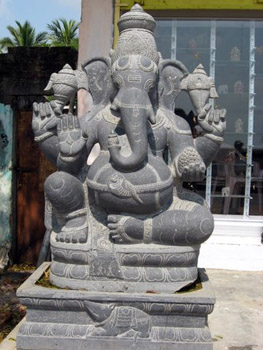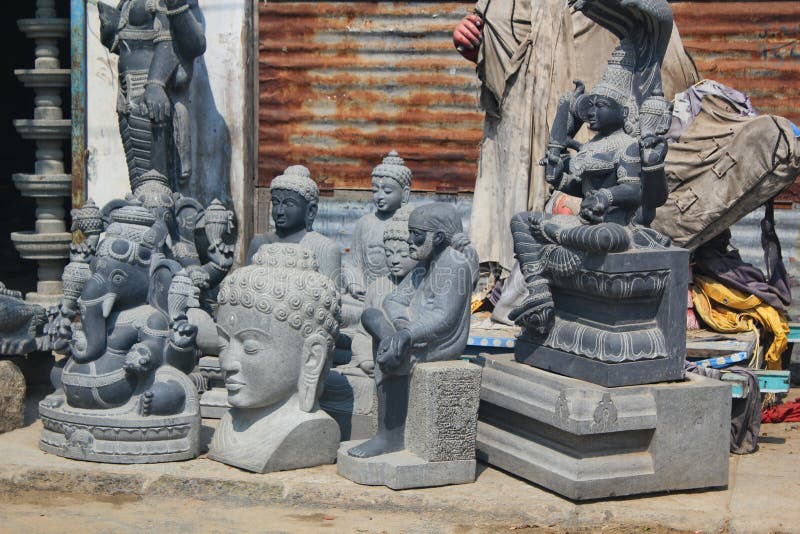ॐ श्री गुरुभ्यो नमः ॐ श्री शिवानन्दाय नमः ॐ श्री चिदानन्दाय नमःॐ श्री दुर्गायै नमः
Source of all Images in this Blog-post : Google Images : ‘Google Image Search’ will reveal the multiple sources of every single image shared here. For more details, kindly see ‘Disclaimer‘
One of the most beautiful cities in South India, Mahabalipuram or Mamallapuram is named after the great Pallava ruler Narasimhavarman-I.
Filled with relics, monuments and some of the most beautiful temples in the world, Mahabalipuram was an important sea port of the Pallava dynasty from the 7th to the 10th centuries.
Mahabalipuram sea-shore temple Often referred to as the “Land of Seven Pagodas” based on an ancient Hindu legend, Mahabalipuram is a city known for its grandeur, hand carved monolithic structures, shrines and the Rathas or cave temples.
The descent of the Ganges is the world’s largest bas-relief sculpture depicting tales from the Mahabharata.
The legendary stone-built Shore temple, which is a mammoth architectural wonder, is believed to be the only one surviving among the seven pagodas.
Mahabalipuram is known worldwide for its intricately designed stone-carvings & stone sculpture. These idols of Hindu gods and goddesses are ready to sell in Mahabalipuram – a UNSESCO World Heritage Site.
These idols are exported to different parts of the country from here. Have a look at some of these ingeniously carved statues, available in a wide range of prices for the art-loving affluent-class :
Buy Mahabalipuram Stone Statues Online on Amazon India
Here’s an article by Chandana Banerjee written for https://travelthruhistory.com/ The Stone Artists of Mahabalipuram :
Mahabalipuram, a historical seaside town near Chennai, Tamil Nadu, is renowned for its rich tradition of stone sculpture, a legacy that dates back to the Pallava dynasty. The town’s ambiance is permeated by the rhythmic sounds of sculpting – the scraping of stone, the hammering of chisels, and the drilling into rock, echoing the ancient art that flourished under the patronage of kings like Mahendravarman and his son Narasimhavarman I. This tradition gave rise to iconic structures like the monolithic Rathas, Arjuna’s Penance, and the Shore Temple, crafted between 600 and 728 A.D.
The streets of Mahabalipuram are lined with numerous sculptors who meticulously transform stone, metal, and wood into intricate pieces of art, continuing the legacy of their ancient predecessors. Among these artists is Mr. M. Durrai Raj, an award-winning sculptor, whose showroom, ‘Mayan Handicrafts’, displays an array of deities and mythological figures, skillfully carved and ranging from a foot to over seven feet in height. These sculptures, known for their quality and craftsmanship, are shipped worldwide.
The Government College of Architecture and Sculpture in Mahabalipuram plays a pivotal role in preserving this art. Established in 1957 to revive the art of sculpture, the college has produced many of the town’s sculptors, who continue to keep the tradition and heritage alive. The town’s sculptors, including self-taught artists like Elumalai, create a range of sculptures from small, portable idols to larger pieces, using diverse materials like red marble and green stone.
This vibrant community of sculptors in Mahabalipuram not only keeps alive an ancient art form but also attracts tourists from around the world. The process of sculpting involves selecting the right stone, sketching the design, and meticulously carving and smoothing the figures, sometimes using electric drills for larger sculptures. Mahabalipuram, through its rows of studios and shops, continues to narrate stories in stone, bridging the gap between the past and present, and preserving the legacy of the Pallava kings.
Buy Mahabalipuram Stone Statues Online on Amazon India

In the bustling lanes of Mamallapuram, a diverse array of statues, including majestic granite elephants and fierce lions, share space with an array of deities. The interiors of the local shops are a testament to this rich artistic tradition, with numerous idols occupying every nook and corner, from the crowded shelves to the cramped floor space.
The town’s sculptural heritage showcases a wide range of craftsmanship and provenance. Master sculptors demonstrate their skill in exquisite creations, while apprentices contribute with their own growing expertise. Among these, the figure of Ganesha, the revered elephant-headed deity known for bringing fortune, emerges as a favorite motif.
Within the walls of Durrai Raj’s renowned establishment, the artistic interpretations of Ganesha are particularly striking. The deity is depicted in various forms—dancing, reading, playing musical instruments, in a relaxed pose, or deep in meditation. These stone sculptures, varying in size from a modest one foot to a towering seven feet, are chiseled from diverse types of stone.
Not only are these intricate sculptures celebrated locally, but they also find appreciation globally, being dispatched to various corners of the world as well as throughout India. In addition to Durrai Raj’s shop, numerous other studios dot the area, bustling with sculptors passionately engaged in bringing their artistic visions to life.
Buy Mahabalipuram Stone Statues Online on Amazon India
Another sculptor, Dashnamoorthy, a seasoned artist, who is an alumnus of the Government College of Architecture and Sculpture at Mamallapuram, has turned the portico of his house into a studio and shop. There he creates medium-sized stone sculptures of gods and goddesses, and sells them to tourists who saunter by.

Navigating the dusty bylanes of Mamallapuram, one witnesses a scene marked by the vibrant hustle of sculptors at work. The town’s air is filled with the lively hum of activity and the distinct sound of drills cutting through stone.
In one of the many active workshops, a sculptor in brown pants and a once-white shirt is seen deeply engrossed in chiseling a granite sculpture of Lord Shiva. Nearby, another artist, donning faded jeans and a psychedelic shirt, is seen operating a drilling machine on a stone slab, meticulously working to reveal the delicately drawn shape of an idol.
In a different section of the studio, the artistic fervor continues. Here, a sculptor shapes a large statue of Lord Vishnu, while another applies clay to a model of Buddha, each absorbed in their craft.
Amidst this creative chaos, wrapped in a thin layer of smoke from the kiln, Rajendra, a lecturer at the College of Sculpture and a specialist in bronze sculptures, is seen guiding a trainee with his metal creation. He also shares insights into the process of making these metal figures, contributing to the rich tapestry of knowledge and skill that defines Mamallapuram’s sculptural heritage.

Rajendra, with 20 years of teaching experience, shares that figurines are typically made using five metals, predominantly comprising 80% copper and 20% brass, with smaller amounts of lead, gold, and silver. The College, instrumental in producing over half of Mamallapuram’s sculptors, was established by the government in 1957 to revive the ancient art of sculpture and temple making, a specialty of the town since the times of the powerful Pallava Dynasty. Sculpture has since become the main occupation in Mamallapuram, with a museum showcasing over 3000 pieces by students.
Most local sculptors are college alumni, though some have learned the trade from family members. Despite no direct lineage traced back to Pallava sculptors, a strong bond exists between the town’s monuments and modern sculptors, sustaining the cultural heritage.
Elumalai, a self-taught sculptor and friend of Rajendra, notes that tourist season (September to January) brings brisk business. His own work, focused on small idols made of red marble and green stone, caters to the middle class, offering affordable and portable sculptures.
Elumalai, fluent in English, explains the process of sculpture-making. It begins with selecting the right stone, sketching a rough outline, chiseling around it, and then refining the details like ornaments and facial features. Smaller pieces are smoothed with salt paper, while larger ones require special tools. Some figurines are inked black, and electric drills are used for bigger sculptures.
In Mamallapuram, numerous studios and shops create and sell sculptures in stone, brass, and wood, with stone being the most popular medium. The city is a testament to its rich sculptural history, from ancient cave carvings to contemporary creations, reflecting a continuity of techniques and themes.
Mythology and deities play a crucial role in both the ancient monuments and the modern sculptures of Mamallapuram, a tradition that has continued since the establishment of the local sculpting college. Stone remains the preferred medium, echoing the practices from the era of the Pallava Kings. Despite variations in styles over time, the essence of sculpting in Mamallapuram remains consistent, revolving around the theme of etching stories into stone.
Conclusion
In conclusion, Mahabalipuram stands as a living museum of stone sculpture, bridging ancient artistry with contemporary skill. The town is not just a testament to the Pallava dynasty’s architectural genius but also a beacon of enduring tradition, where modern sculptors continue to breathe life into stone. As one wanders through its lanes, past studios buzzing with creativity, it becomes clear that Mahabalipuram is more than a historical site; it is a vibrant, living canvas where stories of mythology and devotion are etched in stone. This enduring art form, nurtured by a dedicated community and a supportive educational framework, ensures that the legacy of the Pallava sculptors lives on, making Mahabalipuram a unique and invaluable cultural treasure.



